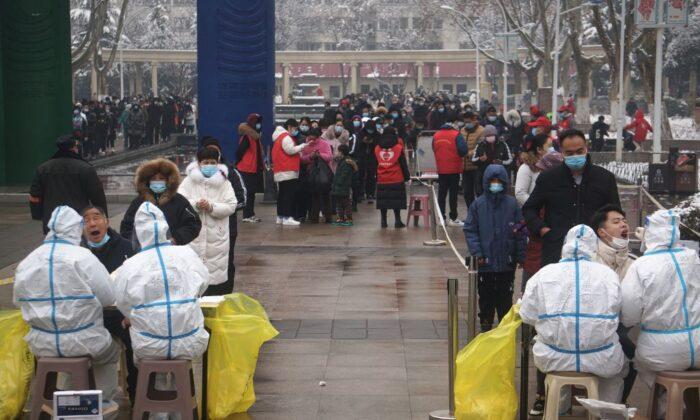When the World Health Organization (WHO) announced the outbreak of swine flu, some experts predicted that if swine flu combined with the avian flu in Asia, it would probably cause a genetic mixing of the swine flu and the avian flu, and the result would be very serious.
Currently, H1N1 has already spread in China, but many local officials intentionally hide the outbreak for the sake of promoting their political careers and block H1N1 tests on suspected patients.
Shanghai World Expo an Excuse to Hide the Spread of H1N1
Shanghai resident Mr. Lin told a New Tang Dynasty Television (NTDTV) reporter that hospitals in Shanghai have all received orders from the “higher-ups” to not conduct H1N1 examinations because Shanghai will be holding the World Expo. “Presently, hospitals do not conduct H1N1 exams. Even if one goes to a hospital specializing in treating H1N1 infections, people will be treated like normal flu patients and won’t know whether they have the H1N1 virus.”
Details are also lacking in Southeast China’s Jiangxi Province. Recently a female student died of H1N1 at Lantian College in Jiangxi Province. Her classmate, Zheng, told a Sound of Hope (SOH) Radio reporter that H1N1 has spread on campus for more than a month and has caused several deaths, but it has been covered up.
“She went to the First Hospital of Nanchang University for emergency treatment, but she died. It was H1N1, but no one reports on it. We students talk about it among ourselves, and our teachers also talk about it. The school does not let the public know how serious the H1N1 outbreak is. The First Hospital of Nanchang University is designated to treat H1N1. They have treated many H1N1 patients. I heard there were hundreds.”
A daily average of 140 patients with fever visit the Nanchang City Ninth Hospital, another hospital designated to treat H1N1 patients in Nanchang City, Jiangxi Province. Last week there were over 300 such patients every day, with one day having 350 patients with fever. When there are more flu patients, there are also more H1N1 patients, according to a report on Dec. 3 by Information Daily. jxnews.com.cn/xxrb/system/2009/12/03/011259786.shtml
One staff member of the Nanchang City Ninth Hospital told an Epoch Times reporter that although this hospital is designated to treat H1N1 patients, it does not have the authority to confirm the diagnosis of H1N1. “Currently we indeed have a relatively high number of H1N1 patients. We also have many more who are hospitalized. In Nanchang City, only the municipal Disease Control Center (DCC) and the provincial DCC can confirm the diagnosis of H1N1. No hospital can confirm [H1N1 cases].”
Cases Go Unreported
In Weihai City, Shandong Province of Northeast China, a staff member of a hospital told a reporter that she contracted H1N1. She recovered, but the hospital did not include her case in the reported number of H1N1 infections.
She said that at least 200 patients came to her hospital and 90 percent of them are H1N1 patients. “These cases cannot possibly have been reported.
“The first day I had a fever of 101° F. The second day my temperature was as high as 104° F, and it lasted for four to five days. I went to the hospital. I was diagnosed with H1N1. Later, when I recovered, I found out that my case was not reported.
“Health bureaus in some areas do not try to diagnose serious pneumonia patients. There is an unspoken rule that a high H1N1 death toll indicates poor disease control.”
Deaths From Vaccine Reactions
The Chinese regime has reported that only four people have died after receiving H1N1 vaccine injections.
On Nov. 25, the Health Bureau of Gansu Province in North China reported that 114 people had shown abnormal reactions after receiving the H1N1 vaccine injections from the first batch of vaccines. An Epoch Times reporter called the Health Bureau of Gansu Province to ask for the causes of the abnormal reactions.
A staff member at the Immune Programming Division of the Lanzhou City (capital of Gansu Province) DCC avoided the reporter’s question. When asked about the vaccine, he said: “The second batch of vaccines is safe and effective. You can get the information from the Web site of the Health Bureau.” The reporter continued to ask: “What is the difference between the second batch and the first batch? Why do you say it is safe and effective?” The staff member said: “Why do you ask this question?” and then hung up the phone.
The Health Bureau of Gansu Province reported the latest death toll from H1N1 infections was 10 people, but they did not give any detailed information about the fatalities.
When asked by the reporter about the true death toll, the staff member of the Gansu Province DCC said that he does not have the authority to release this information. He said that most deaths are from middle-aged people. A municipal DCC staff member stated that only the provincial Health Bureau has the authority to release the information about H1N1.
In 2003, during the SARS epidemic, Chinese Communist authorities, in order to pursue economic development, pressured local officials about the “control” of the epidemic and told those officials that they would be dismissed from their positions if SARS infections occurred in their area. As a result, the reported number of SARS was zero for each locale.
Zhong Nanshan, director of the Guangzhou Institute of Respiratory Diseases in China’s Southern Guangdong Province, expressed his concern about the reassortment (genetic mixing) of H1N1, the virus that causes swine flu, and H5N1, the virus that causes avian flu. He said, “Inside China, H5N1 has been existing for some time, so if there is really a reassortment between H1N1 and H5N1, it will be a disaster.
“This is something we need to monitor—the mutation of the virus. This is why reporting the death rate must be really transparent,” according to an interview with Reuters Television.



